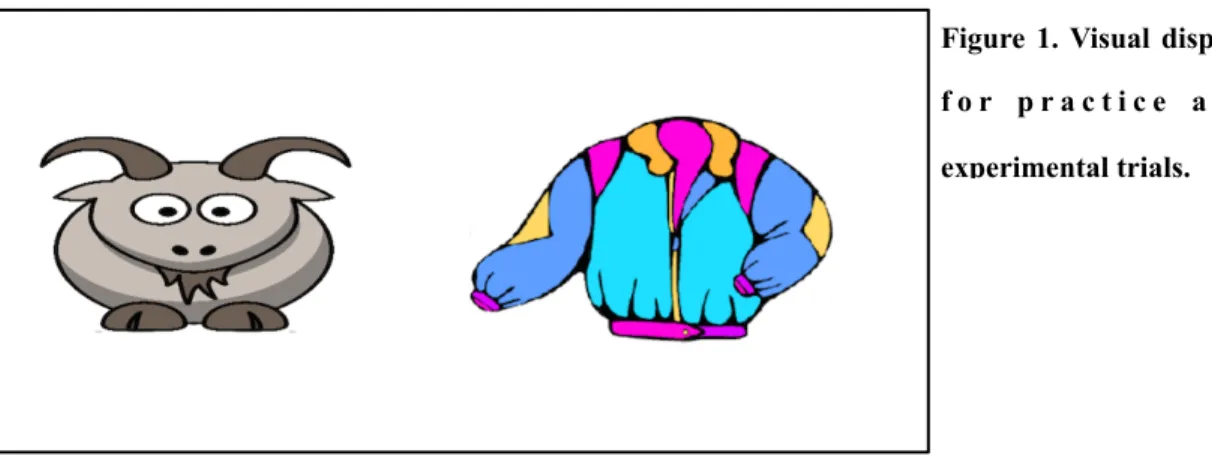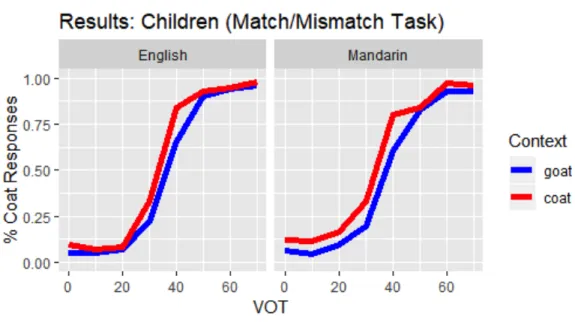The boy milked ___,” and this is especially the case when listening to a non-native (vs. native) speaker (Schertz & Hawthorne, 2018). Recent evidence from Schertz and Hawthorne (2018) suggests that listeners adjust their phoneme categorization strategies and their weighting of cues when listening to a non-native speaker. Since non-native speech is often less intelligible by other means, listeners can further alter their weighting of cues by paying more attention to the sentence context.
To test this hypothesis, Schertz and Hawthorne (2018) conducted a study that used a 9-step VOT continuum from 5ms (a good initial /g/) to 85ms (a good initial /k/) to test how participants weighted acoustic signals and sentential. context when listening to a non-native versus native talker. While Schertz and Hawthorne found that acoustic cues were most important in categorizing the phonemes overall, they also found that listeners weighted the sentential context more highly for the non-native speaker.
Integrating Cues for Phoneme Categorization: Children
Experiment 1: Picture Selection
Methods
For each trial, the participant heard a sentence ending in a VOT continuum between goat and coat. Each speaker produced four sentences that could be completed with coat (but not goat) and vice versa, for a total of eight unique sentences (Table 1). An example of a coat-biased sentence would be “The young lady learned how to dress.
One coat character was spliced at the end of a single sentence produced by each speaker. Each speaker's manipulated words were then inserted at the end of each of the eight sentences. In addition, there were four practice trials with different contextually distorted sentences ending in goat or jacket.
They then saw images of both a goat and a coat appear on the screen (Figure 1) and had to select which image matched the last word of the sentence they had just heard. The photos of the goat and the fur were each randomized based on which image appeared on the right versus left. Two of the lists began with a block of native English speakers, and the other two began with a block of non-native English speakers. The conversation blocks then alternated from native to non-native speakers, and items were randomized within each block.
The dependent variable was whether participants responded indicating fur or goat, which translates into a /k/ or /g/ categorization of the original phoneme.
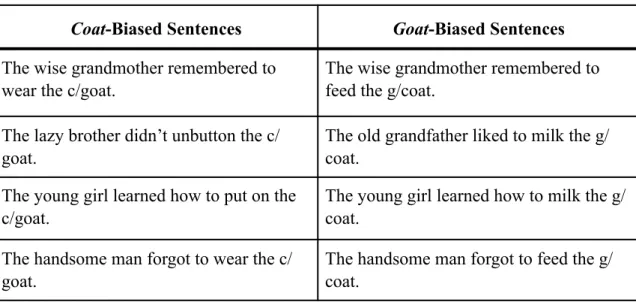
Results
The independent variables were speaker (three native, three non-native), sentence context (four biased goat, four biased hair), and VOT (0–70 ms in 10 ms increments). The lines in each graph represent whether the sentence was contextually biased to end with goat or coat. The gap between the lines tending to the mantle and the lines referring to the goat suggests an effect of context.
The model included fixed effects of speaker L1 (native vs. non-native; contrast coded), sentential context (coat- vs. goat-biased; contrast-coded) and VOT (0-70ms in 10ms intervals; centered). In addition, the model included random contrasts for participant and item and random slopes for VOT and speaker L1 by participant. Random effects by participant account for individual variability, while random effects by item account for item-level variability. jas) answers for the Mandarin speakers.
There was also a significant interaction between speaker L1 and context (β = .43, SE = .14, p = .0028), indicating that the effect of context depended on whether the speaker had a native or non-native accent had. Because there was a significant interaction of context by speaker L1, simple context effects for each type of speaker were examined separately using the testInteractions function from the phia package (De Rosario-Martinez, 2015) in R. This corresponds to the prediction that adults would use the sentimental context more for the non-native speaker; however, it differs from previous findings (i.e., Schertz & Hawthorne, 2018) in that context it was not used regardless of L1 status.
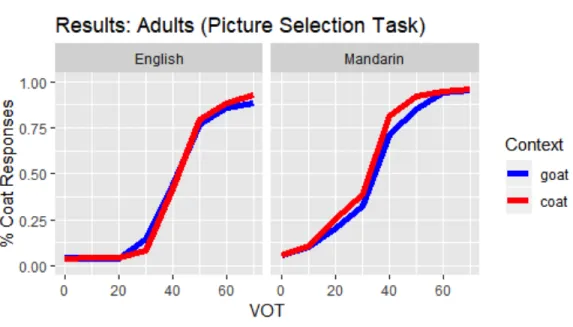
Interim Discussion
Experiment 2: Match/Mismatch
All participants completed the language background questionnaire, mentioned in Section II.A.1, and received additional points in exchange for their participation. The same basic procedures, stimuli, equipment, and design of Experiment 1 were used for Experiment 2.I, except for the task change. Unlike Experiment 1, in which participants selected a picture of a jacket or a goat to indicate whether each sentence ended with a goat or a jacket, participants in Experiment 2 indicated whether or not a single picture matched the last word in the sense that they just heard.
The control sign and X remained in the same positions for each trial, but whether the goat or the coat appeared on the screen was randomly randomized. Note that while we did not have participants bilingual from birth in the previous experiments, they would have met our default inclusion criteria). The children were offered a small toy, and the children's parents were offered a small amount of money in the form of a gift card if they brought their child to the university lab.
First, while adults were conducted exclusively in the university laboratory, children were conducted either in a quiet room at their school or home, or in the university laboratory. In contrast to Experiment 1 and Experiment 2.I which totaled 384 sentences, Experiment 2.II consisted of 192 sentences: 4 speakers * 6 sentences * 8 VOT steps. Verbal responses were the same or different to indicate whether the goat or coat they saw on the screen matched or did not match the last word in the sentence they had just heard.
Again, outliers were trimmed using procedures described in Section II.B, except that responses were considered outliers if more than four seconds elapsed between the end of the sentence and the child's response.
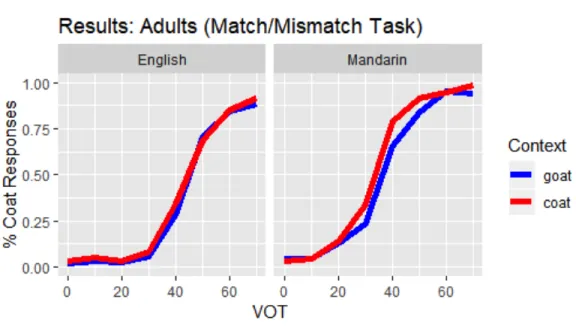
Discussion
Furthermore, the failure to find a context effect for native speakers with the picture selection task (but not with our match/mismatch task) further supports the finding from Experiment 2.I that the context effect is stronger when listening non-native speakers, to the extent that the effect for native speakers disappeared. Our second research question asked whether children ages 5–13 show adult weighting of acoustic and contextual cues when listening to native and non-native speakers. Like adults in Experiment 2.I, children weighted acoustics (VOT) the most, and showed a context effect for both natives and non-natives.
These findings advance our understanding of how children make use of sentential context when listening to non-native speakers. Holt and Bent (2017) found that children aged 5–7 years benefited from punishment context while repeating native and non-native speech. While performance was generally better for native speakers, crucially, the effect of context did not differ between the native and non-native speakers.
Creel, Rojo, and Paullada (2016), on the other hand, studied the interaction of multiple cues (contextual and visual cues) in preschool children perceiving non-native and native speech using four different experiments. In contrast, we found a significant effect of sentence context, which did not differ depending on whether the interlocutor had a native or non-native accent. Another possible reason for the differences in results is the non-native speakers' first language.
Californians) may have more exposure to the non-native accent they used than the children we tested (Mississippians) have exposure to the non-native accent we used.
Limitations
Previous work has shown that even experience with an accent over the course of an experiment leads to less use of contextual information (e.g., Schertz & Hawthorne, 2018). Finally, our sample size for children was not very large and we tested a fairly wide age range from 5 to 13 years. If we look further at a smaller number of ages, or proportionately at a larger number of children from a range of ages, we can make more reliable statements about the way in which children perceive non-native speech.
Specifically, future research could explore the weighting of older children's cues to see when their responses become adult-like, meaning that an interaction between speaker accent and usage will be found. of the speech context. Additionally, it would be interesting to look at the cue weights of younger children to see how cue integration changes with decreasing age.
Conclusion
- Does your child have any vision impairments (with or without glasses)? __ Yes __ No If yes, how old was your child when you first realized he/she had vision impairment? __
- Does your child wear corrective lenses or glasses? __ Yes __ No
- Does your child have any hearing loss? __ Yes __ No
- Does your child wear a hearing aid? __ Yes __ No
- Has your child ever been diagnosed with a speech or language problem? __ Yes __ No If yes, how old was your child when he/she received the diagnosis? __
- Has your child ever been treated for a speech or language problem? __ Yes __ No If yes, how old was your child when he/she received the hearing aid ? __ 1
Very few previous studies have investigated the interaction of multiple cues or compared various age groups of children listening to non-native speech, so the present results are key to advancing our knowledge of the topic. The effect of age and exposure in the development of L2 accent perception (PMC Working Paper series Are there interactive processes in speech perception. Preceding vowel duration as an indicator of the perception of the voicing properties of word-final consonants in American English.
Answer the following questions about the language(s) spoken by your parents (or other adults in your household when you were growing up). For each language listed above, please indicate the average percentage of time you currently use each language (these percentages should add up to a total of 100%). On a scale of 1 (novice learner) to 10 (complete native speaker), how would you rate your ability to speak this language?
On a scale from 1 (beginner) to 10 (complete native), how do you rate your ability to understand this language. Child's ethnicity (please check one): ___ Hispanic/Latino ___ Non-Hispanic/Latino Your ethnicity (if different from the child's): ___ Hispanic/Latino ___ Non-Hispanic/Latino What is your highest level of education . Yes __ No If yes, how old was your child when you found out he/she was visually impaired?
If so, how old was your child when you first realized he/she was visually impaired? If so, how old was your child when he received corrective lenses or glasses? If so, how old was your child when you first realized he/she had a hearing loss?
